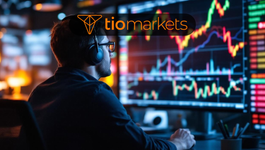Master Forex Trading in 7 Simple Steps | How to master Forex trading
BY TIOmarkets
|11 4, 2022Would you like to master Forex trading but not sure where to start? Forex trading can be profitable, but it’s also complex and risky.
With forex trading, you can make a lot of money, but you can also lose a lot of money. So it’s important to have a solid understanding of how the market works before you start trading.
But don’t worry, we’ve got your back. Our guide to forex trading will help you get started by teaching you the basics of how to trade currencies.
We’ll show you how to develop a trading strategy that fits your personality and risk tolerance, and we’ll also provide tips on how to stay disciplined while trading.
Read on for more information:
1. Start With a Demo Account
When you first start out in forex trading, it’s important to get a feel for the market and test out your trading strategy. A demo account is a perfect way to do this.
Demo accounts allow you to trade virtual money in a real-time market environment, and this will give you a good idea of what it’s like to trade forex and whether your strategy is successful.
Plus, it’s a great way to get familiar with the market and learn how to place orders. So if you’re new to forex trading, be sure to start with a demo account.
2. Define Your Goals
When it comes to trading, defining your goals is essential. Without a clear understanding of what you hope to achieve, it will be difficult to develop a successful strategy.
Are you looking to make a quick profit? Or are you trying to build up your long-term capital? Once you know your goals, you can begin to develop a plan that will help you achieve them.
If your goal is to make a quick profit, then you will need to focus on short-term trades. However, if you are looking to build up your long-term capital, then you will need to focus on longer-term trades.
Regardless of your goals, it is important to have a clear understanding of what you hope to achieve before you begin trading.
To master Forex trading, you need clear direction and work towards that goal.
3. Understand the Market
The foreign exchange market is one of the most dynamic and exciting markets in the world, and currency prices are constantly fluctuating in response to a range of factors.
These include such things as economic news, political developments, and even natural disasters. As a result, it can be difficult to predict how the market will move in the future.
However, by gaining a good understanding of how the market works, you’ll be better equipped to make informed trading decisions.
There are a number of factors that can affect currency prices, and it’s important to be aware of these. Economic news is one of the major drivers of currency prices.
If a country’s economy is doing well, its currency is likely to strengthen. On the other hand, if a country’s economy is struggling, its currency is likely to weaken.
Political developments can also have an impact on currency prices. For example, if there’s uncertainty about a country’s political situation, investors may sell that country’s currency.
Hard as it may be to imagine, natural disasters can also have an effect and cause currency prices to fluctuate.
If a hurricane hits a major producing country like Brazil, for example, it could lead to higher commodity prices and a stronger Brazilian real.
By understanding these factors, you’ll be better better positioned to master Forex trading.
4. Develop a Trading Strategy to Master Forex Trading
A trading strategy is a set of rules that you follow when entering and exit trades. Having a clear trading strategy will help you manage your risks and make consistent profits in the long run.
There are many different strategies that you can use, so make sure to find one that suits your goals and risk appetite. Some common trading strategies include trend following, scalping, and contrarianism.
Trend following involves riding the wave of an asset’s price movement in a particular direction. Scalping refers to taking small profits on a large number of trades over a short period of time.
Contrarianism entails taking a position against the prevailing market sentiment. No matter which strategy you choose, make sure to test it out on a demo account before risking any real money.
5. Master Forex trading With Risk Management
Risk management is an important part of forex trading. There are a number of different tools that you can use to manage your risks, such as stop-loss orders and limit orders.
By using these tools, you can protect your capital and avoid making losses that exceed your tolerance level.
For example, if you have a risk tolerance of $100 per trade, you can use a stop-loss order to close your position if the market moves against you and your losses reach $100.
This way, you can limit your losses and avoid taking on too much risk. Similarly, you can use a limit order to take profits when the market moves in your favor.
By using these risk management tools, you can help to ensure that your losses are kept to a minimum and that you always have a chance to make a profit.
6. Stay Up-To-Date With Market News
Staying up to date with market news is important for anyone looking to trade in the stock market. By remaining informed about potential opportunities and threats, traders can make sound choices and avoid costly mistakes.
There are numerous sources of market news, from financial news websites to economic calendars, and it is up to the individual trader to determine which source or combination of sources works best for them.
By staying current with market news, traders give themselves a better chance of success.
7. Have Realistic Expectations
When it comes to trading forex, it’s important to have realistic expectations. The market is always fluctuating and there’s always risk involved, so you can never guarantee profits.
However, by being realistic and staying disciplined, you can weather the ups and downs of the market and come out ahead in the long run.
There will be times when you make money and times when you lose money, but as long as you stick to your plan and don’t let emotion get in the way, you’ll be able to succeed in the long term.
Is Forex Trading Predictable?
Many people believe that forex trading is a form of gambling, but this is not true. While there is always risk involved in any type of investing, forex trading can be predictable if you have a sound strategy in place.
By following the tips above and staying up-to-date with market news, you’ll be able to make informed trading decisions and move towards your goal to master Forex trading.
In order to be successful in forex trading, you need to have a clear understanding of the market and how it works. You also need to be disciplined in your approach and have a solid risk management strategy.
What Are the Risks of Forex Trading?
There are two main types of risk in forex trading: market risk and credit risk. Market risk is the chance that the market will move against you, and credit risk is the chance that your counterparty will default on its obligations.
To manage these risks, you need to have a clear understanding of the market and your own trading strategy. You also need to use stop-loss orders and limit your leverage.
By taking these precautions, you can minimize your risks and give yourself a better chance of making profitable trades.
What Is the Best Forex Trading Strategy?
When it comes to beginner forex trading tips, there is no one size fits all approach. Different strategies can be useful in different market conditions.
For example, a trend-following strategy may work well when the market is trending up but not so well when the market is choppy or range-bound.
Likewise, a carry trade may be profitable in a low-interest rate environment but less so in a high-interest rate environment. So what is the best forex trading strategy?
The answer is that there is no simple answer. The best strategy is the one that suits your goals and risk appetite.
If you are willing to take on more risk for the chance of higher rewards, then a trend-following or carry-trade strategy may be appropriate.
However, if you are risk-averse and are looking for steady returns, then a range trading strategy may be more suitable.
How Much Money Do I Need to Start Forex Trading?
When it comes to forex trading, the amount of money you need to start depends on a number of factors. If you’re planning on trading with leverage, for example, you can trade with a very small account.
However, it’s important to remember that leverage can magnify both profits and losses. So, if you’re new to forex trading, it’s generally a good idea to start with a small account and trade without leverage.
When Is the Best Time to Trade Forex?
The best time to trade forex is when the market conditions are favorable. When the EUR/USD pair is most active during European and US trading hours, it’s a good time to trade that currency pair.
Some currency pairs are more active at certain times of the day, so it’s important to find a pair that suits your schedule.
Another factor to consider is the political and economic stability of the country whose currency you’re interested in starting to trade in.
What Is a PIP?
A pip is the smallest unit of price movement in forex trading. For most currency pairs, a pip is equal to 0.0001. So, if the EUR/USD pair moves from 1.1500 to 1.1501, that would be a one-pip move.
Pips are used to calculate profits and losses in forex trading.
How Do I Calculate My Profits and Losses?
To calculate your profits or losses in forex trading, you need to know the pip value of the currency pair that you’re trading. The pip value is the amount that you can expect to gain or lose for each one-pip move in the market.
For example, if you’re trading the EUR/USD pair and the EUR is the base currency, then each pip would be worth $0.10.
So, if the market moves 100 pips in your favor, you would make a profit of $10. If the market moves against you by 100 pips, you would incur a loss of $10.
What Is Leverage?
Leverage is a loan that your broker provides to you to enable you to trade with more money than you have in your account. Leverage can be a useful tool, but it can also magnify your losses.
So, it’s important to use leverage wisely and only trade with an amount that you can afford to lose.
What Are Margin Calls?
A margin call is a demand from your broker for you to deposit more money into your account to cover losses you have incurred. If you do not meet the margin call, your broker may close out some or all of your open positions.
Margin calls are typically made when your account equity falls below a certain level, known as the maintenance margin.
What is a Stop-Loss Order?
A stop-loss order is an order that you place with your broker to sell a currency pair if it reaches a certain price. Stop-loss orders are used to limit losses in forex trading.
For example, if you place a stop-loss order at 1.1500 on the EUR/USD pair, your broker will sell the currency pair if it falls to 1.1500.
What Is a Limit Order?
A limit order is an order that you place with your broker to buy or sell a currency pair at a certain price. Limit orders are used to take profits in forex trading.
For example, if you place a limit order at 1.1550 in the EUR/USD pair, your broker will buy the currency pair if it rises to 1.1550 or sells it if it falls to 1.1550.
What Is a Market Order?
A market order is an order to buy or sell a currency pair at the current market price. Market orders are typically used to enter or exit a trade quickly.
Ready to Master Forex Trading?
If you want to master Forex trading, follow these 7 simple steps. By doing your research to educate yourselves, observing the markets over time, you can develop a well-rounded Forex trading strategy.
So start by learning more, follow our daily analysis and register your account today.
Risk disclaimer: CFDs are complex instruments and come with a high risk of losing money rapidly due to leverage. You should consider whether you understand how CFDs work and whether you can afford to take the high risk of losing your money. Never deposit more than you are prepared to lose. Professional client’s losses can exceed their deposit. Please see our risk warning policy and seek independent professional advice if you do not fully understand. This information is not directed or intended for distribution to or use by residents of certain countries/jurisdictions including, but not limited to, USA & OFAC. The Company holds the right to alter the aforementioned list of countries at its own discretion.
Join us on social media

Behind every blog post lies the combined experience of the people working at TIOmarkets. We are a team of dedicated industry professionals and financial markets enthusiasts committed to providing you with trading education and financial markets commentary. Our goal is to help empower you with the knowledge you need to trade in the markets effectively.





